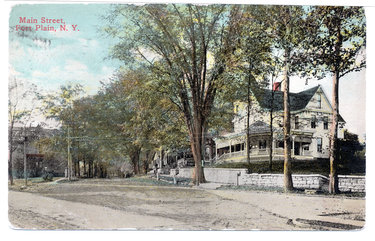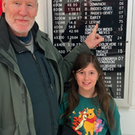Fond childhood memories compelled me to help Fort Plain right itself
— Submitted by Ellen Zunon
Still standing: The central building was the Farmers and Mechanics Bank in 1922 when Ellen Zunon’s grandmother sent this postcard from Fort Plain to her grandfather in Schenectady. The building has seen a number of different uses since that era and is now known as Montgomery Hall. “The town clock still chimes the hour every hour from the clock tower,” says Zunon who was inspired by fond memories of Fort Plain to help with clean-up after the recent floods.
— Submitted by Ellen Zunon
Vintage view: “Before there was Facebook or Twitter, before e-mail or telephones, people kept in touch with friends and family with postcards,” Ellen Zunon writes in a blog post, “A Penny (Postcard) For Your Thoughts,” at http://twocookbooks.blogspot.com/2013/05/a-penny-postcard-for-your-thoughts.html. A century ago, her grandparents corresponded through postcards during their courtship and the early years of their marriage, as her grandmother lived in Fort Plain and her grandfather worked in Schenectady’s General Electric plant. On the back of this card, her grandmother wrote about one of her sewing projects and her washing and ironing chores and recounts how their young son says, “I am going to tell my daddy” every time somthing happens to him.
One day in early July, I stood in line at the Fort Plain Reformed Church with other volunteers waiting to be sent out through the village to help with flood clean-up efforts. Next to me in line stood an Amish woman with her family. Her long skirt and starched white cap contrasted sharply with my jeans, T-shirt, and hiking boots.
She also wore a long gray apron that was already smeared with mud. Oblivious to the smudge of mud on her cheek, she and her companions had already finished mucking out one flooded basement and had returned to the sign-up desk to be sent out to another location.
Soon I, too, was on my way to an address a few blocks away to meet up with a team of local residents and outsiders, armed with buckets, rubber gloves, and shovels, to work on cleaning out three inter-connected basements.
Down the basement steps we went, one by one, feeling our way into a dank dark area with about five inches of mud and dirty water. It was hard to see at first, but, when my eyes adjusted to the darkness, I could see mud everywhere. And I could hear mosquitoes buzzing around my ears.
Directed by a woman in a pink T-shirt whom I knew only as Pat, our crew of five began shoveling mud into our buckets and handing them off to those who carried them brigade-like up the stairs to be dumped at the curb, where trucks would soon come along to remove the piles of muck.
Fort Plain was my father’s hometown. My family’s roots there go back to the 1890s when my great-grandfather ran a grocery and supply store along the Erie Canal. Later, he became the first rural mail delivery worker out of the village, bringing the mail in a horse-drawn buggy or sleigh to the farms in the hills surrounding the town.
As far back as I can remember, I recall trips to Fort Plain to visit my Grandma Minnie, who lived in the house Great-Grandpa bought in 1908. It was these memories of my childhood visits to the village that drew me there to help out after the flooding on June 28.
Over the course of several days, I was given a variety of tasks to carry out: folding and sorting donated clothing, assisting at the resource center where people came to be fed or to pick up free, non-perishable food items and cleaning supplies, and mucking out a few basements.
Among the many local residents I met as well as those who came from outside to offer their assistance, I observed a range of leadership styles. Two styles in particular stand out in my mind.
There was what I might call the “Star Trek” style of leadership, exhibited by individuals who boldly stepped up to direct those who manned the battle stations, in the manner of Captain Kirk. Or “Grab a shovel and a bucket and make it so,” as Captain Picard might have said. The woman I knew only as Pat was that kind of leader.
A more subtle style of leadership made me recall the writings of Chinese philosopher Lao Tzu: “A leader is best when people barely know that he exists . . . he talks little, but, when his work is done, the people will all say, ‘We did this ourselves.’” It was this cooperative style that I observed in those directing the sorting of donated clothing.
In times of crisis, such as last month’s flood in the Mohawk Valley, both leadership styles are needed, and those with natural leadership qualities will invariably manifest themselves.
But, regardless of the leaders who came forward, what mattered most was teamwork. There was a sense of mission in complete strangers coming together to work shoulder to shoulder in muddy basements.
Townspeople and outsiders combined their efforts to hand out food and cleaning supplies. The motto was, “Strangers helping strangers.” The real hero was teamwork.
Flood recovery in the area will be a long-term process. I am glad the government has stepped in, as well as corporate, not-for-profit, and individual donors. The Valley will need much teamwork to continue the recovery effort.


